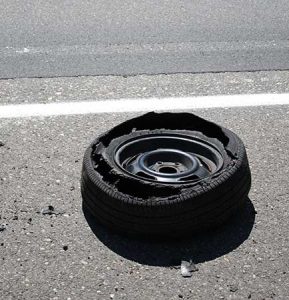
Nails in tyres can lead to catastrophic effects
Nails, screws and other sharp metal nasties have a habit of ending up embedded in our tyres. It’s annoying at any time, but really annoying when the tyre still has plenty of tread remaining. So the big question is ‘Can you repair my tyre?’
Happily, the answer is ‘sometimes.’
Who decides whether the tyre can be fixed?
When a tyre fitter gives you the bad news that your tyre is a write-off, you might wonder if they’re just trying to make a quick profit. However, any responsible tyre company will always give you the option to have the tyre repaired if that is feasible.
The fact is that sometimes a nail causes damage that just can’t be fixed safely. All tyre companies should be following the BS AU 159 guidelines on what types of damage are potentially repairable and what types should not be attempted. These guidelines are produced by the BTMA (British Tyre Manufacturers Association).
Although it might be tempting to bend the rules, they are designed to protect motorist safety. Ultimately, a new tyre is a temporary expense, and that can’t be measured against the danger of a high speed blow-out if an inappropriately-repaired tyre gives out.
Location, location, location
One main factor is whether repair is possible is exactly where the nail or other object is embedded.
Using BS AU 159 standards, the tyre is potentially repairable if the puncture damage measures less than 6mm in diameter and it’s in the central tread section of the tyre. However, if the damage is on the shoulder or sidewall, the tyre will need replacing.
What’s so special about the shoulder and sidewall? The problem is that these areas flex far more than the central tread section, and that makes them more vulnerable to the effects of damage. A nail in the shoulder or sidewall makes the tyre susceptible to sudden blowouts.
Where exactly is the central tread?
One of the problems might be interpreting exactly where the central tread – the repairable area – starts and finishes. However, the BS AU 159 makes it quite clear by providing exact definitions.
Admittedly, they are a bit of a faddle to work out, because they are based on percentages of your tyre width. If you really want to work it out yourself, here’s an example based on a 210mm tyre.
- Using the BTMA’s table (see below), the maximum repairable area for a 210 mm tyre is 70%

- 70% of 210mm is 147mm
- The 147mm repairable area centres on the exact middle of the tyre’s tread. In other words, it extends for 73.5mm from the tyre centre line
- Therefore, if the nail is less than 73.5mm from the centre line, it’s potentially repairable.
If that all seems like too much work, our expert tyre fitters will of course do the work for you.
The nail is in the right area – so you can definitely fix it?
Unfortunately, that’s not quite the end of the story. It’s quite possible to have nail in the repairable area and for the tyre to still be a write-off. For example, if the nail has caused a slow puncture, you may have been running the tyre at reduced pressure for a period of time. This is bad news, as it causes the tyre to heat and flex in ways it was never designed to. This may have weakened the internal structure, again leaving it vulnerable to catastrophic failure. Your fitter will be able to examine the tyre for signs of damage and advise accordingly.
More advice and a premier tyre repair service
We hope that’s our guide has pointed you in the right direction, not left you feeling too flat, and other terrible tyre-related puns. But for proper advice on tyres from a friendly, professional team of fitters, get in touch with BK Tyres today.
